THE LIVE BAIT OPTION
Jamie Crawford unlocks the ultimate live bait secrets.
I’m sure most fisho’s can recall a time they’ve had a fish follow a lure almost to the rod tip, only to peel away at the last second. Or similarly, have cast a dead bait at a passing fish, only to have the offering snubbed. Frustrating, isn’t it?! If it’s happened to you, I bet the words “I wish I had a live bait” ran through your mind.
Sometimes the only way to tempt a wary fish is to present the most realistic offering available, and that offering is a live bait. There’s still no guarantee you’ll get the bite, but if that fish has ignored dead bait and lures, your best bet for drawing a bite is to offer something alive and kicking. A well-rigged live bait cast into a school of fish is rarely refused, and similarly, a live bait dropped down to a deep reef is generally eaten quickly.
The benefits of fishing with live baits are many, but there are also some downsides. The time and preparation needed for collecting and holding live baits is more involved than simply defrosting a bag of bait from the freezer.
You need to have a game plan and set aside the first part of the session for bait collection. This can be hard when the sun is rising and the weather is prime, and there’s a voice in the back of your mind telling you to forego the bait collection and just crack out the lures. You also need to be prepared with a live bait tank of sorts, whether this is just a bucket of water with a batterypowered aerator, or something more extensive such as a hardplumbed bait tank including water exchange. The size and complexity of the live bait tank will be dictated by the size and number of baits you intend to hold.
For housing bait fish or squid, a tank around the 30 litre mark will suffice for holding half a dozen baits, once again depending on the size of the bait and level of water exchange. But for a more serious live baiting session, such as a full day dropping baits around our offshore reefs, you might want to consider a larger capacity tank up to 80 litres. Some of the charter boats run 200 litre chemical drums plumbed on the rear deck, which can hold upwards of 40 live baits. Obviously, they have the deck space available to do this, whereas most private vessels don’t.
Some fishing scenarios might see you using a minimum of 10 live baits in a session per fisher, while in other locations you may only need one or two live baits for the whole session as the bycatch is minimal. There are many variables when it comes to predicting bait usage.
Below I’ll run through some popular live baiting targets and will discuss some tips which will hopefully help you along the way.
YELLOWTAIL KINGFISH
I love chasing kings, but they can be a fickle and frustrating species at the best of times. They are notorious for turning their noses up at most offerings presented to them. We’ve had sessions casting lures at kings for nil interest, but after returning to the school with a live bait we’ve had instant success. On the flipside we’ve also returned to a school of kings and had live baits ignored, so it’s never a guarantee for success.
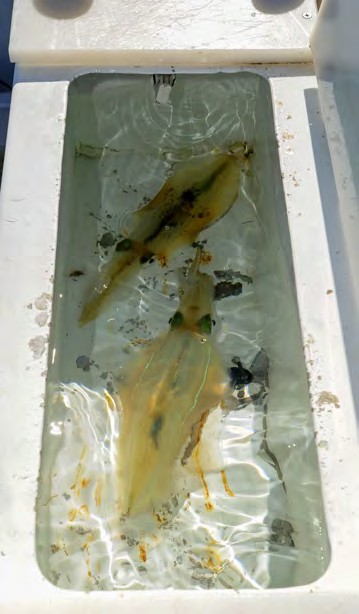
Calamari will stay alive for hours in a decent tank
In the live bait department, a well-presented squid is hard to beat. The downside with squid is they can be hard to cast (without damaging the bait). Everything else loves to eat them too, including snapper, nannygai, sharks and even leatherjackets, so a live squid typically doesn’t last as long as a bait fish in some locations. When using squid, we’re generally using calamari for inshore waters, and arrow squid (if available) around our offshore reefs and islands.
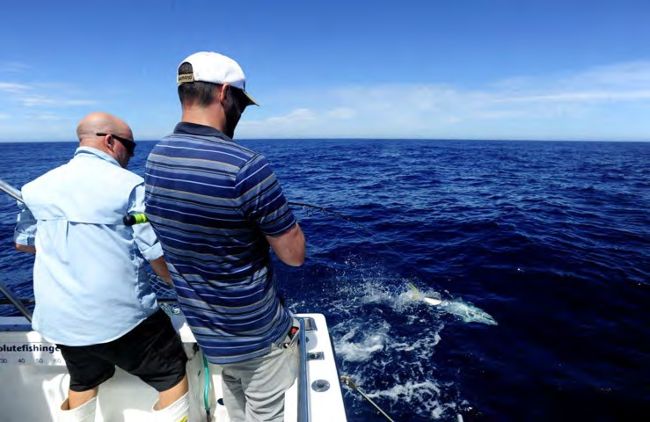
When rigging a live squid, I prefer to use a twin hook rig, and I’ll make several rigs prior to the trip, each with a differing distance between the hooks. In this way if we are using larger squid, I’ll grab a pre-made rig with a larger gap between the hooks, and vice versa for smaller squid. There are plenty of good hooks on the market these days, but personally I use Harbor 11/0 high carbon live bait hooks or Gamakatsu 10/0 chem sharp Big Bait hooks. You want a super strong hook when targeting kingfish, but not too thick in the gauge, as these heavier hooks can damage live baits. I rig my twin hooks at the bottom of a heavy monofilament leader – something around the 100-120lb mark. Kingfish often reside around heavy structure and will try to bury you any opportunity they get, so the heavier leader is often a good option.
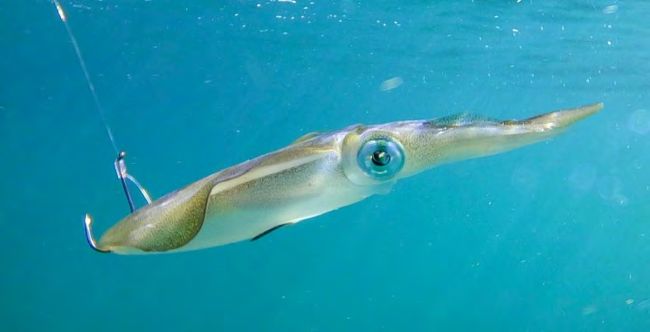
A simple, effective way to present a live squid
When rigging squid as a live bait, I like to pin the top hook through the tip of the hood (but offset so as not to damage the feather), with the bottom hook pinned through the underside of the hood, towards the head. Make sure there is plenty of hook point exposed and that the hooks aren’t pulled to one side, as this can bury the hook points into the body of the squid.
Using live squid is a great option when you’re not casting to fish, but rather setting a live bait from a boat or land-based platform. Squid are a good option when used on a down rigger, or when set under a balloon in shallow water locations. Squid look great under water and they stay alive well on the hooks – generally until something eats them.
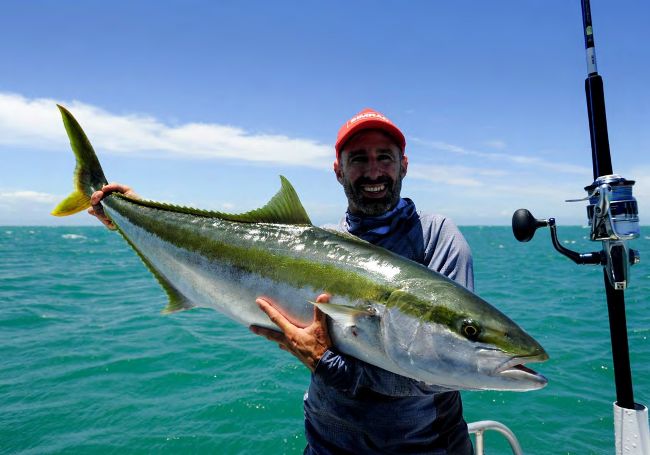
The author with 20kg of livey-caught kingfish
With bait fish there are plenty of options to choose from, and we’ve effectively used salmon trout, garfish, tommies, slimy mackerel, yellowtail scad, silver trevally, King George whiting, trumpeter and even yelloweye mullet when chasing kingfish. The pick of the live baits has to be slimy mackerel and salmon trout in the bait fish department.
When rigging a live bait, I will usually run with a single live bait hook pinned through the nose, or bridle rigged if the bait is of a smaller variety. When fishing in shallow water settings and actively casting at fish, I opt for the single hook and often rigged on lighter leader around 60-80lb due to the fickle nature of shallow water kings. When fishing in deeper water settings and with larger live baits, I’ll use a twin hook rig on heavier mono.
Live fish can be fished on a down rigger, cast unweighted or sent down to a deep-water reef using a running sinker. When fishing in deeper water, circle hooks such as the 13/0 7691 sports circle (produced by both Mustad and Three Yachts) are a popular option and aid in a clean jaw hook-up.
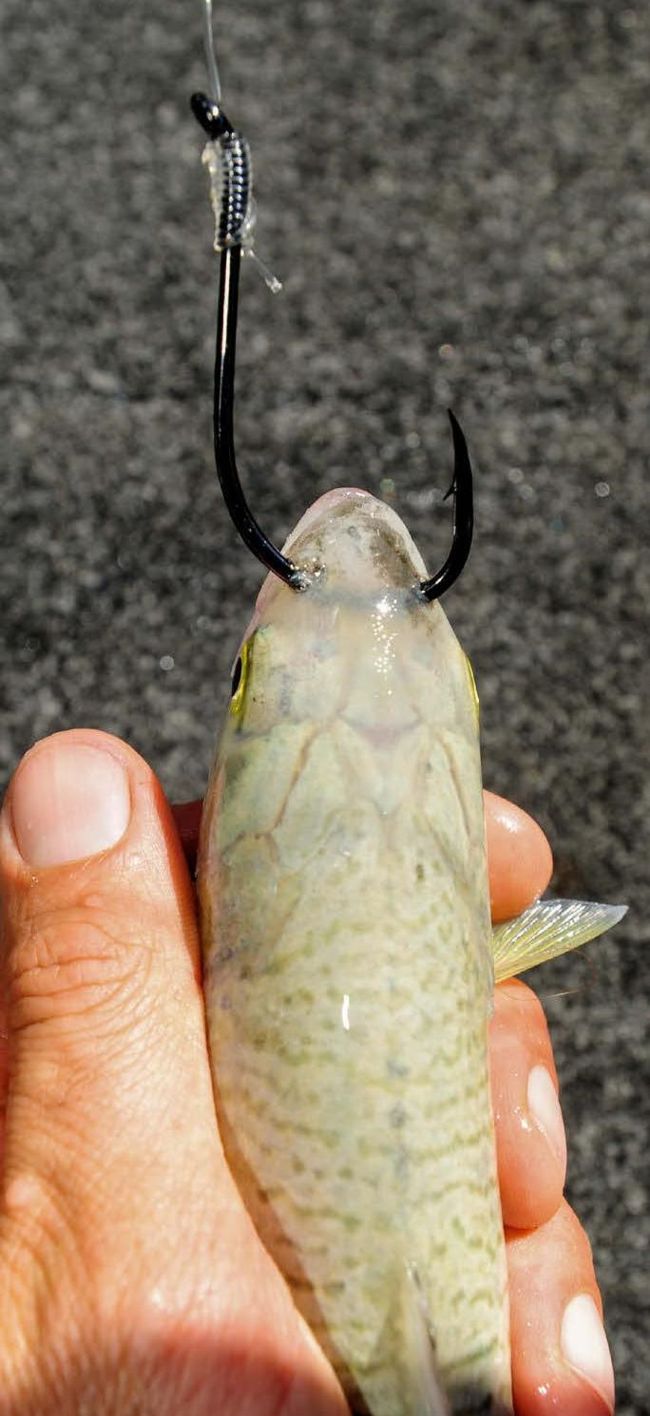
A single hook is fine for salmon trout
SAMSON FISH
Targeting samson fish in deeper water with live baits is very effective, especially if the samsons aren’t schooled up and you’re covering ground while trying to locate some fish. There are some good reefs south of Port Lincoln and wide of York Peninsula which hold small schools of big samson fish during the cooler months, and these fish respond to live baits much better than metal jigs when the water temperature is down during winter.
Live baiting for samson fish is very similar to targeting kingfish in deeper water, and it’s possible to catch both species in the same day when fishing with live baits. It will be necessary to start your day catching live baits from shallow inshore waters before heading out wide to the samson reefs, as the bait fish options out wide can be pretty slim and shouldn’t be relied upon.
Good live baits for samson fish include squid (southern calamari and arrow squid), salmon trout, slimy mackerel, yellowtail scad and tommy ruffs. It is possible to use legal sized swallowtail on the deeper reefs too, but the silversided bait fish generally get eaten first.
I use the same rigging methods when targeting samson fish as I do with kingfish, with a twin hook rig when using squid and larger bait fish, and a single hook (finer gauge) when using smaller bait fish. Don’t be afraid of larger bait fish either, as samson fish have big mouths and will happily eat big bait fish up to 40cm.
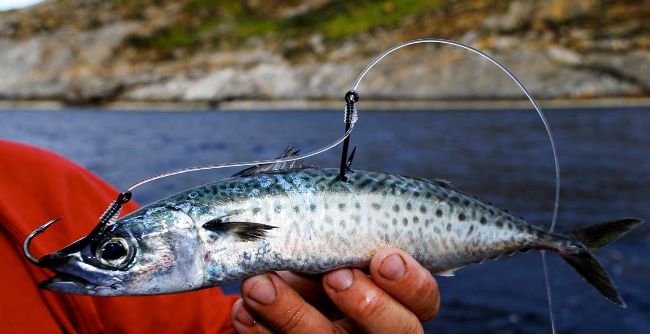
Larger baits, like slimy mackerel, are best presented on two hooks
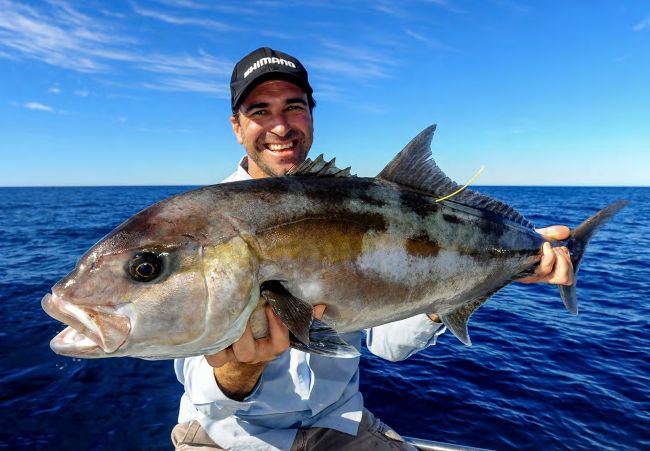
Samsons like live baits as much as their kingfish cousins
When live baiting for samson fish, it’s important to get your live bait down into the feeding zone. Use your sounder to identify markings around your chosen reef, and then use a running sinker to deliver your bait to the right depth (either multiple ball sinkers, or a running sinker clip which allows you to exchange sinker sizes). Samsons will happily feed 10 or 15m up off the bottom, which allows you to set a rod in the holder with a livey off the bottom, and fish for other species closer to the bottom at the same time.
If you lower your live bait too close to the bottom though, you can expect bycatch in the form of blue groper, red snapper and even pink snapper, along with less desirable species such as sergeant baker, blue throat wrasse and ocean jackets.
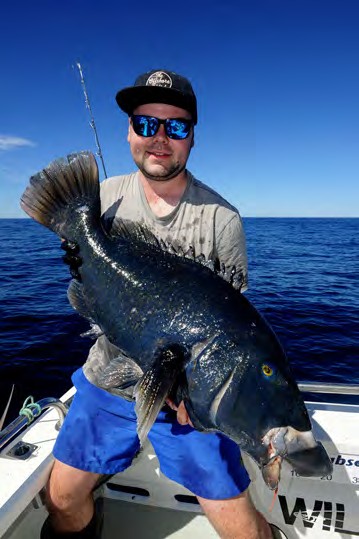
Surprisingly, blue groper will often grab a live bait
MULLOWAY
Mulloway are a species that love eating live baits, although given their environment, it’s not always that easy to offer a livey. I have a mate who spends time collecting live baits in his tinny before each mulloway beach fishing session, and then walks a bucket of livies for several hundred metres at night along a soft beach. He has landed some epic mulloway from a fairly populated area. It’s a lot of effort, but he’s certainly been rewarded for the hard work.
Live baits are undoubtedly the number one bait in the surf. Live salmon trout and mullet are great baits, and it’s possible to catch these on location by using a lighter rod and small baits cast behind the shore break. We’ve also caught live baits from another location and driven them to a surf setting to use as live baits, but keeping enough baits alive for a session is always a challenge. I would recommend three of four live baits each for a session, with some dead baits as back up.
When casting bait fish into the surf, a twin hook rig is preferred. I like using Gamakatsu Octopus 8/0 to 10/0 in the surf, or similarly Mustad Octopus. These patterns have a nice fine hook point, and they offer a good balance of hook up rate and strength. It’s unusual for a hook to be the weak point in a surf fishing setting.
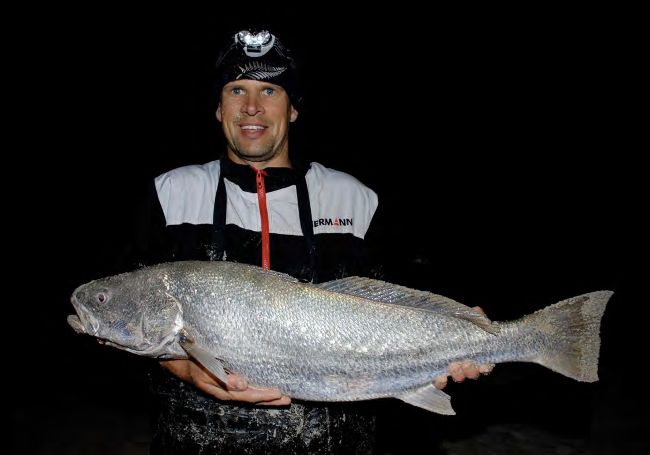
Surf mulloway are suckers for a live mullet or salmon trout
Live baiting for mulloway from a boat is another good scenario, although we are limited with suitable locations here in SA. My early live baiting sessions for mulloway took place in the Coorong in my dad’s boat when I was growing up. Using live mullet when the barrages were releasing fresh water, we used to run our livies into the Murray Mouth under a ball sinker and it used to be very effective, mainly on school-sized fish. Similarly, winter nights in the Port River have seen some great mulloway caught on live baits for those who are prepared to invest the time after dark.
There are also a few wrecks in our Gulfs which offer a few mulloway on live baits, but these fish are often mixed in with snapper, and given the ban, it’s a good idea to give these fish a wide berth for the time being.
SHARKS
A lot of fisho’s may not realise that live fish are great baits for shark. Hammerhead sharks, with their acute sensory system, can home in on a nervous baitfish from quite a distance. If you see a hammerhead finning the surface on a calm summer’s day, a live fish cast in front of the shark will often be eaten before any dead bait. These are best fished on a circle hook with heavy mono rather than a steel trace, as the electroreceptors of hammerheads can sense the presence of metal underwater. If you are using a steel trace, then aim to use a light gauge nylon coated wire such as 0.8mm.
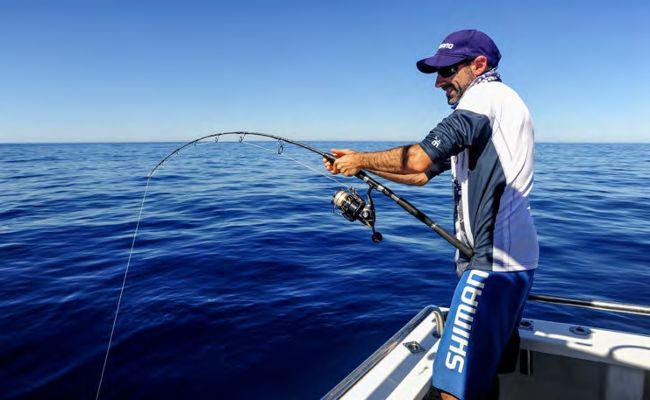
Live baits and bent rods go hand in hand
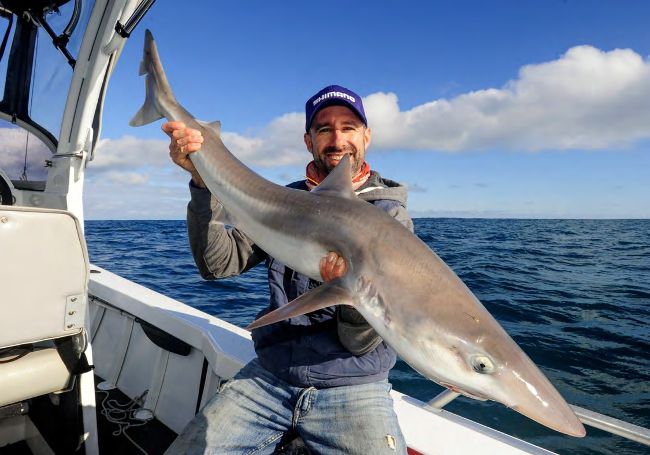
Big school sharks will rarely swim past a live bait
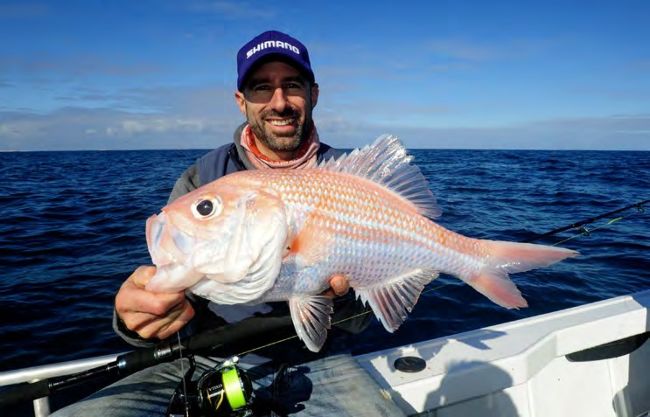
Nannygai will tackle a live chow or slimy
Hammerheads aren’t the only species of shark which respond well to a live bait, with school sharks falling for live fish such as tommies, salmon trout, scad and mackerel when fished down around nannygai reefs. I prefer using 8/0 octopus pattern hooks on these rigs, and I use a 5cm clear line protector which slides over the eye of the hook and protects the mono trace line from the small but sharp teeth of a schoolie.
School sharks will often bite a bait fish in half, so having that second hook pinned through the back often assists in a positive hook up. Once again, use enough lead to deliver the bait fish close to the bottom once some school sharks have been found.
Big bronze whalers are suckers for a live salmon, especially when that salmon is sending out a distress signal. These live baits can be swum out from a beach, and hence no casting, kayaking or ballooning is required. For this style of fishing, you’ll normally wait until a bronzie is spotted in the surf, and then using a freshly caught salmon, swim him back out into the surf with the addition of a forged circle hook through its shoulder.
GOLDEN PERCH
Most people don’t associate freshwater fishing with live baiting, but offering live shrimp or yabbies down against timber in the Murray or on our reservoirs is still a form of live baiting. The flicking motion of shrimps and yabbies can be a trigger for a feeding response for golden perch and other natives in fresh water.
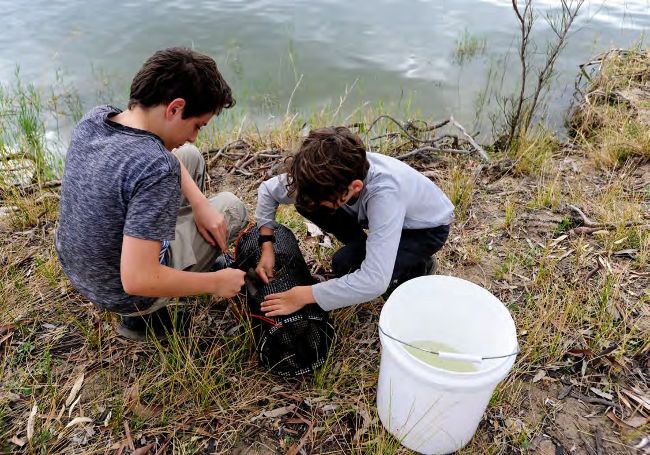
Get the kids onto yabbie and shrimp collecting. They love it!
When fishing with shrimp, I prefer a standard paternoster rig, but when fishing with a yabbie I like to use a single 3/0 hook under a ball sinker, and slowly lower the yabbie down against the timer. A baitcast outfit is perfect for this style of fishing, as line can be slowly fed out, but you are able to retain full contact to feel for that inhaling bite from a golden. Using live yabbies may not get as many bites compared with using smaller baits, but the bites will often come from a better class of fish.
SIDE NOTES
Other things to consider when live baiting (in the fresh and in the salt), is that you have an adequate tank for keeping baits alive, and that you have a scoop net or some other method for catching live baits from the tank. Don’t forget that size limits and bag limits still apply to bait fish, and so too legal methods for capturing them. Live baiting can be a very effective way of connecting to wary fish, or for weaning through smaller fish to select the larger models.

Big callop with smash live yabbies or shrimps